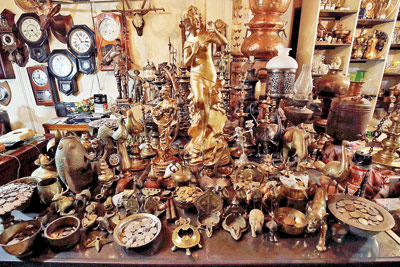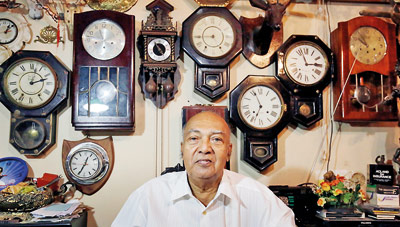Everyone’s junk is this man’s treasure
Chock-a-block is a large wing of a home in Kochchikade, Negombo – not with clutter but a trove of antiques.
Crammed full on the floor, on and atop shelves, hanging on walls and in every conceivable nook and cranny are antiques, most probably the largest collection in Sri Lanka, gathered over the years by retired tea planter Flavian Dias.

Antiques galore. Pix by M.A. Pushpa Kumara
Now 72, Flavian’s childhood gave no indication of his bent towards antiques. With his father being a Registered Medical Officer hailing from Panadura, the family moved from place to place.
Having completed his education, young Flavian decided to try his hand at tea-planting in Maskeliya, joining the Gartmore Group in 1963 under the Soysa family, with guidance being given by H.A.V. Soysa.
Later he moved to the Attampitiya Estate as Senior Assistant Superintendent, having come under the influence of N.H.S. Perera, former Director of Harrison & Crossfield.
His interest in antiques was nudged several years later, when he bought a large brass tray in Dambulla in 1970.
There has been no turning back from the trail of antiques which became wider and more enthusiastic since his retirement as the Superintendent of the Maussa State Plantation in Madolkelle in 1989.
And the trail is dotted with unforgettable landmarks………144 pieces of brass-copper trays, tea-pots, flower-pots and many others that he bought from “a chap who had returned from Saudi Arabia” seven years ago, telephones, pol-katu anguru irons, lamps of varying shapes and sizes, bells aplenty and even haal-seru, some of which he had saved from the melting pot.
Talking of pots, we are shown many a cauldron, one weighing as much as 115 kilos, made of brass and copper and cherished by ayurvedic physicians, with medicines being kept in them for as long as two weeks to mature.
It certainly was not medicine that was kept on a large, beautiful 118-year-old dish along with a gravy boat.
This dish with the emblem of the Ceylon Rifles would have proudly borne a roasted piglet with all its garnishing, with “veins” at the base to drain off the gravy, that Flavian purchased from a person in Negombo.
He also shows off an 88-piece cutlery set, manufactured in Japan but marketed in Saudi Arabia and a large dish used in the Middle East creating an image of a group seated around it tucking into a sumptuous dinner.

Lover of the ‘old’: Flavian Dias
From food to drink we move, with Flavian holding up a bottle of pol arrack, the seal unbroken and the alcohol intact which is 45 years old.
The paper label, of course, has seen the ravages of kavo (silver fish) and he is quick to say that “udath kavo kala, yatath kavo kala”. The memories flow forth how he bought it from a tavern in Badulla in his planting days, for just Rs. 8.50.
Opens, he does, not the bottle of pol but a ‘cellaret’ of Rangoon teak that foreign planters stocked with whiskey, brandy and gin in the days of yore but which he bought off a Muslim mudalali who stored it with papaya and dried fish.
Cellaret is described in the Oxford Dictionary as a cabinet or sideboard for keeping alcoholic drinks and glasses in a dining room.
Each and every item has a tale attached, with Flavian pointing out that through experience he has mastered the art of spotting the antique from the fake.
Sometimes the antiques are brought to his doorstep as his reputation as a collector has spread far and wide and at others he would stop-by paththara kada, step in and cast a quick glance around, picking up old items, during his journeys across the country.
Home he comes then laden with antiques, to the consternation of his wife, Juliet, who shakes her head in despair to find space for them.
“In attempts to clear their homes of what they believe to be junk, many people sell off yakada-badu to the paththara kada to be melted,” he says, adding that younger generations don’t know the value of some of the “old” stuff in their homes.
More tidbits of information, as Flavian points us in this direction and that. Eleven Willcox & Gibbs sewing machines he has, seven of which are still working.
The “classic” one is a “silent machine” manufactured back in 1890, 125 years ago. The sewing machines are not limited to this British brand but have been augmented by 70 more from the Singer company.
We move onto coins, with the oldest being one minted in 1703 under the VOC seal of the Dutch and another prized possession a gold coin of 1911 with the head of George IV of Britain.
Under the glass of his large table, neatly laid out are notes of local currency, including a 10-cent note of 1942 and a rupee note of 1954.
There are also two super-quality Stradivarius violins — one handed down by his mother which is 85 years old and the other more than 200 years old.
Suddenly, there is a blast of music, a dance tune, after a friend of his who was pottering around some gramophones puts on a record.
“During early times, gramophones were made of iron,” points out Flavian, giving a little bit of history. Gradually to reduce their weight, they were manufactured from pittala.
Radios are also part of his possessions, with the second-hand one he purchased from another estate Superintendent for the princely sum of Rs. 250 from his first salary having pride of place.
Wall clocks he has 70 in all, complemented by six grandfather clocks, two of which had been given to him by Simon Fernando, the father-in-law of his son Surakshan.
Those two are of the Junghans brand made in Germany and bought from M/s F.X. Pereira & Sons, First Cross Street, Colombo 1, in 1930.
“This hourly meter I bought from a paththara kade for five rupees,” laughs Flavian, also holding up an instrument box he had purchased closer in time, 1960, just before his examinations at St. Joseph’s College.
A special item is the Chixexer, which can distinguish the sex, whether pullet or cockerel, of chicks as young as a day-old which had been presented to him by Carmel, the daughter of the Deniyaya Estate Superintendent, R.L. Perera. The machine had been bought by Mr. Perera on a visit to London in the 1950s.
An early Petromax lamp brought down and dusted for us to view at close hand, several Menorah (sacred candelabra with seven branches), a bottle embossed with the skull and cross bones and ‘Poison’ written across for all to see, a lion cut out of kalu-gal picked up in Rattota, a road-tracer used on tea, rubber and coconut estates, old scales, stools with antlers as legs, a bell which had been used to summon all the workers for meals at a walauwwe, brass animals strewn over tables and shelves, ink-pads, cigarette lighters and even a thermometer more than 100 years old in perfect working order and much more form his antique-trove.
With every inch holding one or more items, it is only once in a way that they see a duster being passed over them and Flavian does concede that he has now stopped buying antiques as his wife is “dead against” his passion.
He has no personal favourite but loves them all and even though the secret of his collection is “ganu witharai and no denu” (buying but not selling off), Flavian is now feeling the onerous responsibility of maintaining this one-man museum.
What he hopes for is that the authorities would take over his invaluable collection for a reasonable price, leaving behind a few items close to his heart due to their sentimental value.
Then the wide and varied collection will be preserved for posterity, adds Flavian.


